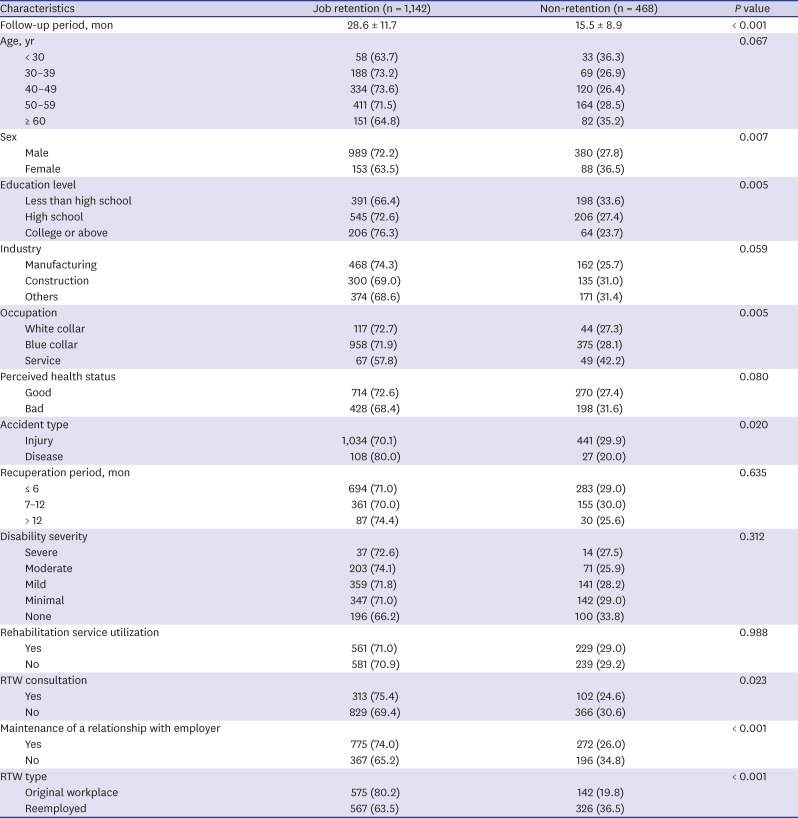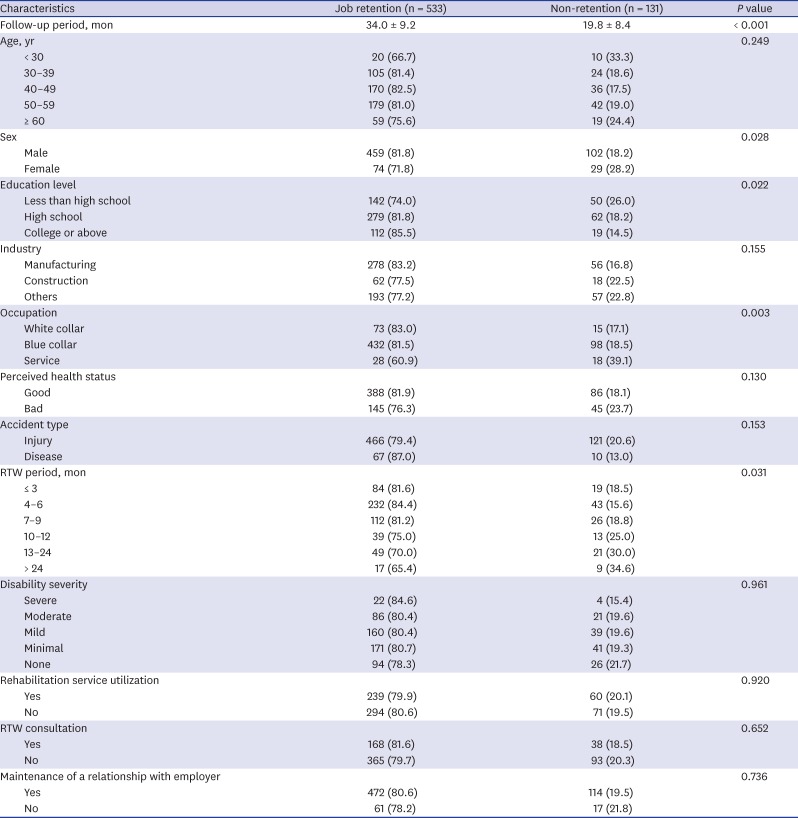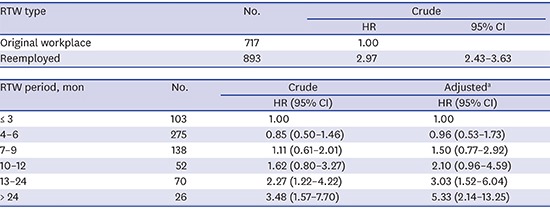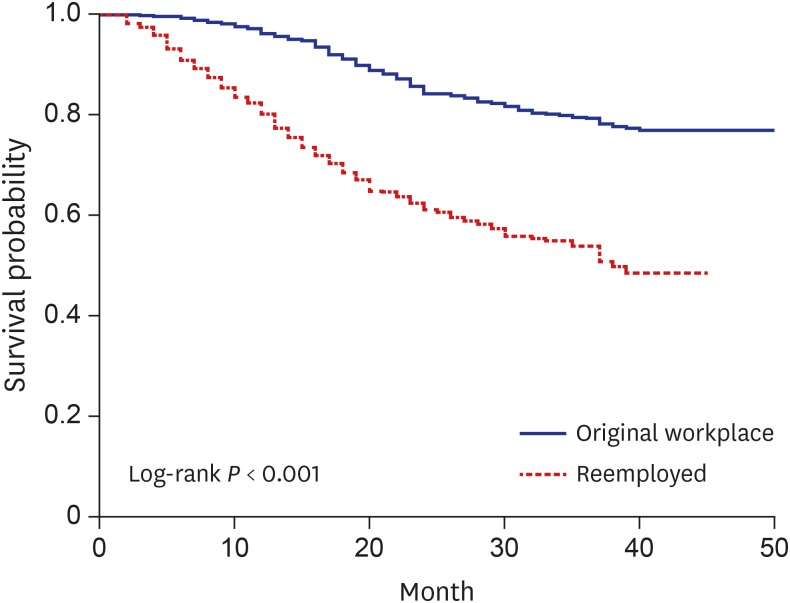1. Ministry of Employment and Labor (KR). Analysis of Occupational Accidents 2015. Sejong, Korea: Ministry of Employment and Labor;2016.
2. Michaels D. Adding Inequality to Injury: the Costs of Failing to Protect Workers on the Job. Washington, D.C.: Occupational Safety & Health Administration;2015.
3. Bültmann U, Franche RL, Hogg-Johnson S, Côté P, Lee H, Severin C, et al. Health status, work limitations, and return-to-work trajectories in injured workers with musculoskeletal disorders. Qual Life Res. 2007; 16(7):1167–1178. PMID:
17616838.
4. Sullivan M, Adams H, Thibault P, Moore E, Carriere JS, Larivière C. Return to work helps maintain treatment gains in the rehabilitation of whiplash injury. Pain. 2017; 158(5):980–987. PMID:
28178073.
5. Ministry of Employment and Labor (KR). The Employment and Labor White Paper. Sejong, Korea: Ministry of Employment and Labor;2016.
6. Baldwin ML, Johnson WG, Butler RJ. The error of using returns-to-work to measure the outcomes of health care. Am J Ind Med. 1996; 29(6):632–641. PMID:
8773723.
7. Berecki-Gisolf J, Clay FJ, Collie A, McClure RJ. Predictors of sustained return to work after work-related injury or disease: insights from workers’ compensation claims records. J Occup Rehabil. 2012; 22(3):283–291. PMID:
22143197.
8. Butler RJ, Johnson WG, Baldwin ML. Managing work disability: why first return to works is not a measure of success. Ind Labor Relat Rev. 1995; 48(3):452–469.
9. Yee SR. An analysis on the labor turnover of the injured workers. Korean J Econ Stud. 2007; 55(2):5–34.
10. Park E. The employment duration at first return-to-work of injured workers. Korean J Soc Welf Stud. 2014; 45(2):123–146.
11. Young AE, Roessler RT, Wasiak R, McPherson KM, van Poppel MN, Anema JR. A developmental conceptualization of return to work. J Occup Rehabil. 2005; 15(4):557–568. PMID:
16254755.
12. Wasiak R, Young AE, Roessler RT, McPherson KM, van Poppel MN, Anema JR. Measuring return to work. J Occup Rehabil. 2007; 17(4):766–781. PMID:
17929149.
13. Steenstra IA, Lee H, de Vroome EM, Busse JW, Hogg-Johnson SJ. Comparing current definitions of return to work: a measurement approach. J Occup Rehabil. 2012; 22(3):394–400. PMID:
22415602.
14. Baldwin ML, Butler RJ. Upper extremity disorders in the workplace: costs and outcomes beyond the first return to work. J Occup Rehabil. 2006; 16(3):303–323. PMID:
16933145.
15. Reisine S, Fifield J, Walsh SJ, Feinn R. Factors associated with continued employment among patients with rheumatoid arthritis: a survival model. J Rheumatol. 2001; 28(11):2400–2408. PMID:
11708410.
16. Kang HT, Im HJ, Kim YK, Ju YS, Lee HP, Kim JM, et al. Predictors of return to work and job retention after work-related injury or illness. Korean J Occup Environ Med. 2006; 18(3):221–231.
17. Kim HS, Choi JW, Chang SH, Lee KS, Oh JY. Treatment duration and cost of work-related low back pain in Korea. J Korean Med Sci. 2005; 20(1):127–131. PMID:
15716617.
18. Amir Z, Moran T, Walsh L, Iddenden R, Luker K. Return to paid work after cancer: a British experience. J Cancer Surviv. 2007; 1(2):129–136. PMID:
18648953.
19. Seing I, MacEachen E, Ståhl C, Ekberg K. Early-return-to-work in the context of an intensification of working life and changing employment relationships. J Occup Rehabil. 2015; 25(1):74–85. PMID:
24920449.
20. Tjulin A, Maceachen E, Ekberg K. Exploring the meaning of early contact in return-to-work from workplace actors' perspective. Disabil Rehabil. 2011; 33(2):137–145. PMID:
20513163.
21. Nguyen TH, Randolph DC. Nonspecific low back pain and return to work. Am Fam Physician. 2007; 76(10):1497–1502. PMID:
18052015.
22. Park SK. Associations of demographic and injury-related factors with return to work among job-injured workers with disabilities in South Korea. J Rehabil Med. 2012; 44(5):473–476. PMID:
22549659.
23. Kim I, Rhie J, Yoon JD, Kim J, Won J. Current situation and issue of Industrial Accident Compensation Insurance. J Korean Med Sci. 2012; 27(Suppl):S47–S54. PMID:
22661871.
25. Korea Workers' Compensation & Welfare Service. A Report on the First Panel Study of Workers' Compensation Insurance. Seoul, Korea: Korea Workers' Compensation & Welfare Service;2014.
26. Go DK, Yoo SH, Song J, Won JU, Roh J. Factors associated with patients’ willingness of return-to-work in industrial accident hospitals. Korean J Occup Environ Med. 1998; 10(3):379–387.
27. Ross CE, Mirowsky J. Does employment affect health? J Health Soc Behav. 1995; 36(3):230–243. PMID:
7594356.
28. Schönherr MC, Groothoff JW, Mulder GA, Eisma WH. Vocational perspectives after spinal cord injury. Clin Rehabil. 2005; 19(2):200–208. PMID:
15759536.
29. Young AE. Employment maintenance and the factors that impact it after vocational rehabilitation and return to work. Disabil Rehabil. 2010; 32(20):1621–1632. PMID:
20158373.
30. Won JU, Yu JY, Kwon YJ, Kim Y, Rhie JB, Jeong IC. A new disability rating method according to the job using the Korean Academy of Medical Science disability guideline. J Korean Med Sci. 2012; 27(12):1453–1459. PMID:
23255842.








 PDF
PDF Citation
Citation Print
Print





 XML Download
XML Download